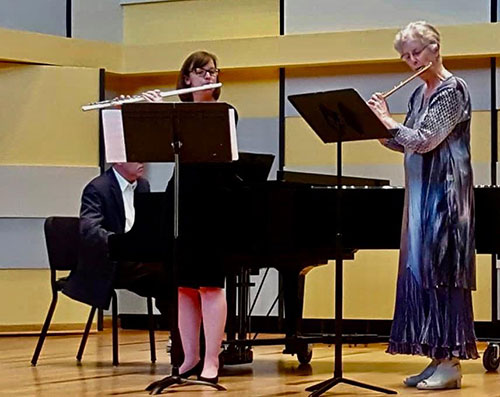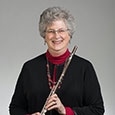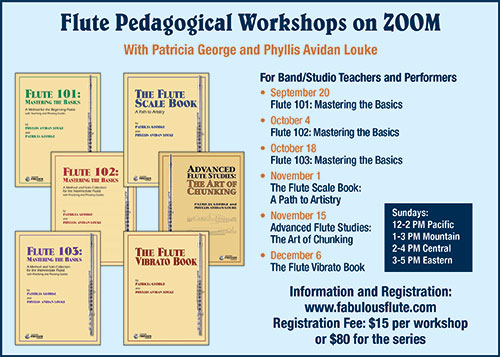
From the very beginning of my flute life, that is private lesson flute life, I have been inspired by, learned from, and enjoyed playing flute duets. Whether playing them with colleagues, students, or guest artists, duet playing always provides inspiration and information. I frequently program duets on recitals to provide a contrast for the audience, and often my students program a duet with their best flute friend from our studio.
Duet playing has been part of the pedagogy of flute from the beginning of our history. The repertoire is diverse, varied, and rich. In the Flute Book, Nancy Toff writes, “The Breitkopf Thematic Catalogue, published by that leading Leipzig publisher from 1762-1787, lists some three hundred duets for two flutes.”
François Devienne (1759-1803), flute professor at the Institut National de Musique, wrote his Nouvelle méthode théorique et pratique pour la flute in 1794. This method was used for over 100 years at the Paris Conservatory and contains his pedagogical approach to teaching through a series of duets. The Six Sonatas are among my favorites. Subsequent methods such as those by Henri Altès and Taffanel & Gaubert contain duets of all levels, teaching everything from dotted eighth and sixteenth notes to different articulation markings, and melodic styles. In the 18th and 19th centuries, before the advent of radio and compact disks, composers arranged duets from their popular operas. If you don’t know these works, you might enjoy exploring the opera duets by Mozart, Rossini, and others.

My first duet book was the Selected Duets, Vol. 1 published by Rubank, edited and selected by Himie Voxman. As a high school student, duets were always at the end of the lesson. In a way duet playing was a reward for being well-prepared with fundamental exercises, scales, etudes, and repertoire. But in reality, this time may have been the most important part of the lesson. I learned both parts of each duet (we often exchanged parts), and I looked forward with great anticipation to making music with my teacher. Sometimes we sightread the next duet in the Voxman book. At the time, I didn’t realize that my listening skills and ensemble playing were improving. I gained so much from this weekly ritual.
I specifically remember playing the J.B. Loeillet Sonata No. III in the second Voxman book, where I discovered the joy of dissonance or “the spice of life.” For the first time I heard the buzzing of difference tones. A difference tone is a faint tone produced in the inner ear by two simultaneously sounded musical tones. The pitch of the buzzing is calculated by subtracting the vibrations per second of the lower note from the upper note. On the flute these notes are most easily heard with notes in the top of the middle octave on up. For an experiment, have one flutist play a middle octave A, and the other a middle octave F. Each should continue slowly playing up an F Major scale listening for the buzz.
As my teacher guided me, I learned the concept of tension and release along with artistic vibrato usage, where to breathe, make dynamic nuances, balance with the other part, and matching tone colors. I also learned how and where to conduct, how to adjust to just intonation, match note lengths and of course phrasing style. Learning to read the two lines of score was another benefit from playing duets. All of the skills one needs to perform well in ensembles of all sizes can be learned while playing duets. Modeling from a great player instills fine skills and habits, often without talking through the how.
Through the years I initiated playing duets with colleagues and friends. One time, two of us ventured out in a canoe on the Connecticut river near Hanover, New Hampshire to a remote island to play duets in nature. Unfortunately, we forgot that mosquitoes might be in abundance. How reckless, but it was fun!! Many an evening was spent with fellow flute students reading all of the Telemann Canonic Duos with each of us trying to outdo the other with tempo and embellishments.
A memorable evening was spent when the legendary French flutist Jean-Pierre Rampal was in town. Several of us had the chance to play Kuhlau Duos, Op, 80 with him. With delight, he tested us, accelerating faster and faster.
Each year at The Ohio State University High School Flute Workshop, I include duets on my opening recital as a way of introducing and including a colleague or graduating student. During the workshop sessions, students and counselors play duets as a pedagogical tool. Duets invite cooperation, collaboration and friendship, showcasing the great challenges and joys of musicmaking.
In teaching, duet playing is a way to motivate students. The purpose may be to improve the flutist’s sightreading skills or developing their musicianship. It is also a way to bring a studio together socially. When working as a team, flutists share practice strategies, how to collaborate and how to be a good colleague. As an entrepreneurial assignment, I have students design a program and then find a performance venue.
The repertoire for two flutes is varied and substantial. Each era has many works to be studied and performed. In recent times, composers have added to the repertoire by writing duos for two flutes and piano, flute and piccolo, flute and alto flute, etc. In addition, there are all of the duets in the orchestral repertoire, some presented in Great Flute Duos from the Orchestral Repertoire by Jeanne Baxtresser, Renée Siebert and David Cramer. Another option in playing duets is to take Baroque sonatas. Have one flutist play the melody, and the other play the basso continuo. Playing the basso continuo enhances bass clef reading and helps with understanding the nature of the piece. Playing the basso continuo on the bass flute is another option. In the end, duet playing is a great pleasure to be enjoyed regularly, even with physical distancing!
Some of My Favorite Duets
Twenty-first Century
Nicole Chamberlain: Chatter for two C flutes (https://nikkinotes.com/Compositions.html)
Ian Clarke: Maya for two flutes and piano (Ian Clarke)
Daniel Dorff: Folk Song Suite (Presser)
Miklós Kocsár: Tone-colour Games (Edition Budapest)
Michael Lösch: Klezmer Duets (Universal)
Liz Sharma: Dances (Forton)
Twentieth Century
Richard Rodney Bennett: Conversations (Universal Edition, UE 14154)
Ingolf Dahl: Variations on a Swedish Folksong (flute and alto flute)
Jindrich Feld: Cinq Inventions (Leduc)
Thom Ritter George: Six Canonic Sonatas (Southern)
Paul Hindemith: Kanonische Sonata (Schott)
Charles Koechlin: Sonata, Opus 75 (Salabert)
Robert Muczynski: Duets, Opus 34 (G.S.)
Goffredo Petrassi: Dialogo Angelico (Zerboni)
Shulamit Ran: Sonatina (Presser)
Nicolas Roussakis: Six Short Pieces (American Composers Alliance)
Roman Ryterband: Dialogue (Hug)
Gary Schocker: Traditional Korean Melodies, Traditional Taiwanese Melodies; Little Helpers;
Over the Moat; Spelunking, Syllogisms (Presser)
Harvey Sollberger: Two Pieces (McGinnis & Marx)
Nineteenth Century
Franz Doppler: Opéras Favors (Billaudot)
Louis Hugues: School of the Flute, Opus 51, Divided into 4 grades (Ricordi)
Friedrich Kuhlau: Opus 10, 39, 80, 81, 87, 102 (various)
Camille Saint-Saëns: The Carnival of the Animals, arr. Seubel (Barenreiter)
Bedrich Smetana: The Moldau, arr. Seubel (Barenreiter)
Eighteenth Century (multiple editions)
W.F. Bach: Six Duets
Michel Blavet: 15 Duets, Six Sonatas; Variations on a Theme of Corelli
W.A. Mozart: Opera Duets from the Magic Flute, Marriage of Figaro, Six Duets, Opus 75
Joachim Joachim Quantz: Six Duets
Georg Phillip Telemann: Canonic Duets, Opus 2, Series 1 & 2
Collections
Album of Flute Duets, Louis Moyse (G. Schirmer)
Classic Duets, Mary Karen Clardy (Universal)
Duets for Fun, Gefion Landgraf (Schott)
Mozart Operatic Highlights (Universal)
Oeuvres Originaes, Louis Fleury (Leduc)
Selected Duets, Volume 1 & 2, Himie Voxman (Rubank)
Twelve Bite Size Pieces, Mike Mower (Itchy Fingers)
• • •
Teaching Tips
Decide who conducts the beginning of the piece, any accelerandos/diminuendos in the movement, and cues the final cutoff.
Practice stopping and starting.
Practice looking at the other player at the beginning of every phrase.
Trade parts to decide who has the melody and who has the accompaniment.
Explore dynamics and balance issues.
Identify and listen to intervals for tuning.
Listen for difference tones for tuning.
Match tone color and vibrato speeds and widths.
Match note lengths.
Practice with a metronome to be sure both parts are accurate rhythmically.







